Physical Address
304 North Cardinal St.
Dorchester Center, MA 02124
The sphenoid bone is located at the central skull base and is commonly considered the most complex bone in the human body. Although the sphenoid bone is often neglected in relation to the adjacent temporal bone, it forms the major boundary between the intra- and extracranial structures. The various sphenoid foramina to the orbits anteriorly and neck spaces inferiorly are pathways for transmission of disease.
This chapter highlights the normal sphenoid bone anatomy and various disorders affecting the skull base. Understanding the anatomy will enable clinicians to predict intra- and extracranial disease spread and presentation.
The sphenoid bone forms the central skull base and viewed anteriorly resembles a bird with its wings unfurled. It is a compound bone with a median body and paired lateral greater and lesser wings ( Fig. 3.1 ). At the ventral junction of the body and wings the paired pterygoid processes arise inferiorly, resembling the extended limbs of a bird.
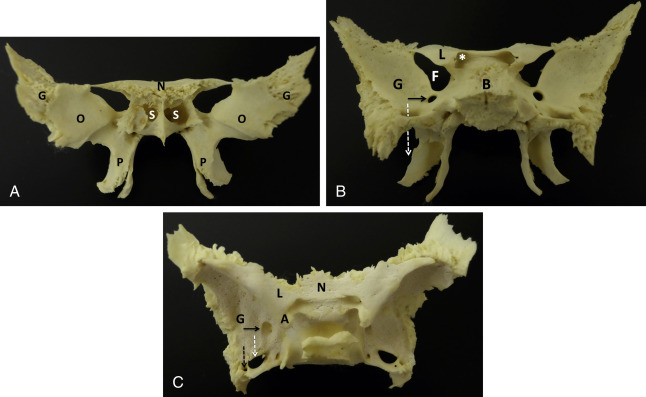
Of interest, the Greek origin of sphenoid (sphen) is likely in reference to a wedge shape seen laterally, with pterygoid (pteron) referring to a fin- or wing-like shape. Another theory for the origin of “sphenoid” is the term os sphecoidale, meaning “bone resembling a wasp.” The term is apt given the resemblance to a winged creature. At some point a transcription error to “sphenoidale” may have occurred with loss of the true meaning.
Anteriorly the sphenoid bone articulates with the ethmoid and frontal bones, laterally with the temporal bones, and posteriorly with the basiocciput. Essentially, the sphenoid functions as an attachment site for the majority of the masticator musculature and serves as a key conduit for the passage of nerves and blood vessels of the head and neck. Major foramina and fissures include the optic canal, foramen rotundum, superior orbital fissure, and foramen ovale ( Figs. 3.2–3.5 ).
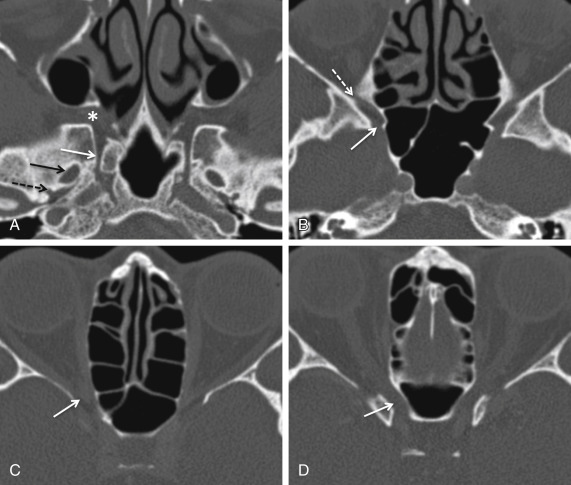
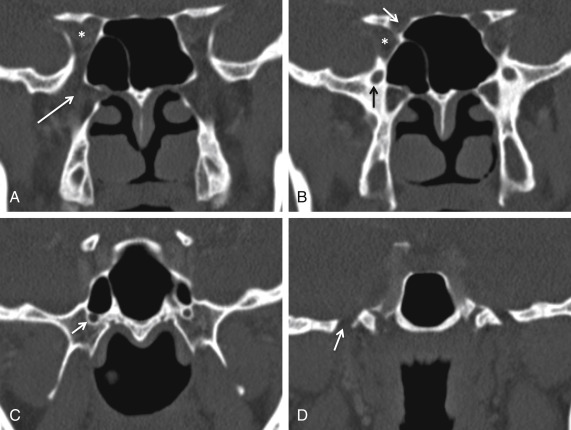
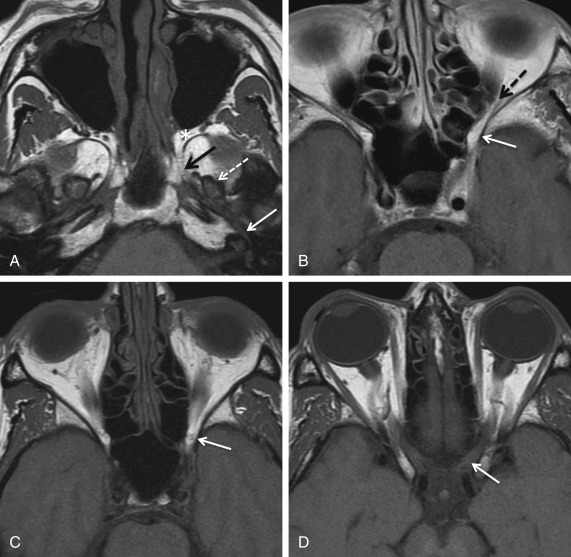
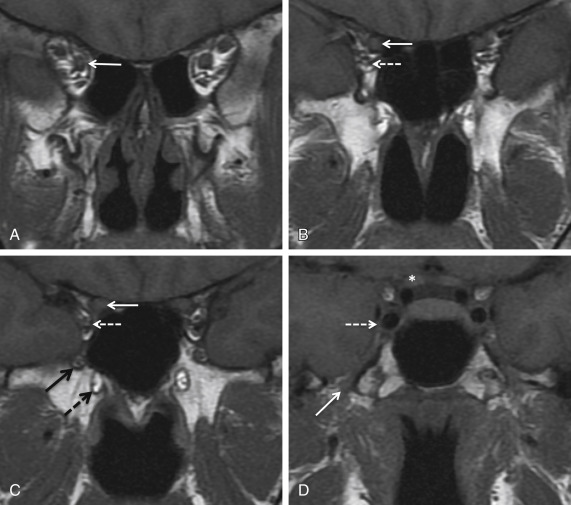
The body of the sphenoid contains the sphenoid sinuses and the pituitary fossa (sella turcica), a deep saddle-shaped depression containing the pituitary gland (hypophysis). The anterior margin of the pituitary fossa (tuberculum sellae) continues anteriorly as the flat superior surface of the sphenoid, termed the planum sphenoidale. This forms the anterior roof of the sphenoid sinuses and articulates with the cribriform plate of the ethmoid bone, which transmits small fibers of the olfactory nerve.
The posterior margin of the pituitary fossa (dorsum sellae) continues inferiorly as the basisphenoid, which articulates with the basiocciput forming the clivus (Latin for “slope”). The clivus continues posteroinferiorly to the foramen magnum, with the petroclival fissures forming the lateral borders. The inferior clivus forms the bony roof of the nasopharynx.
Anteroinferior to the sella turcica are the paired sphenoid sinuses. The thin anterior wall of the sinuses and face of the sphenoid body articulate with the nasal septum at the sphenoidal crest. At either side of the crest are the sphenoid sinus ostia allowing drainage of secretions into the sphenoethmoidal recesses and then into the superior nasal cavity. The lateral borders of the sphenoid bone/sinuses form the medial cavernous sinus walls and are commonly indented by the carotid arteries. The posterior walls of the sinuses are formed by the anterior clivus, which can be of variable thickness, depending on the extent of sinus pneumatization.
The lesser wings or orbitosphenoids are paired thin triangular plates that extend laterally from the planum sphenoidale. Medially they arise from the anterior and superior sphenoid body at two roots. These roots define the optic canal ( Figs. 3.2–3.5 ), which transmits the optic nerve and ophthalmic artery. It is the only canal passing through the lesser wing and is separated from the superior orbital fissure inferolaterally by the optic strut (lower root).
The superior orbital fissure ( Figs. 3.2–3.5 ) is a comma-shaped gap between the lesser and greater wings of the sphenoid bone appearing thin superolaterally and bulbous inferiorly. It transmits cranial nerves (CNs) III, IV and VI (oculomotor, trochlear, and abducens), branches of the ophthalmic division of the trigeminal nerve (CN V1), and several vessels including the ophthalmic veins. In addition, the annulus of Zinn, common tendinous origin of the four rectus muscles, straddles the superior orbital fissure centrally and encircles the optic canal.
The inferior surface of the lesser wing forms the upper boundary of the superior orbital fissure and the posterior orbital roof. The flat superior surface serves as a platform for the basifrontal lobe and posteromedial extensions form the anterior clinoid processes, which are the attachment sites of the tentorium cerebelli.
The paired greater sphenoid wings, or alisphenoids, arise from the body of the sphenoid medially and curve superiorly and laterally. The greater wings contribute to the formation of the orbit and middle cranial fossa.
At the orbit, the medial margin of the greater wing forms the inferior margin of the superior orbital fissure and the posterolateral margin of the inferior orbital fissure ( Figs. 3.2 and 3.4 ), which transmits the zygomatic branch of the maxillary nerve (CN V2). The orbital portion of the greater wing also forms the posterolateral wall of the orbit.
The cerebral or superior surface of the greater wing forms the majority of the concave middle cranial fossa and has a number of foramina passing through it.
The foramen rotundum is a circular aperture seen at the base of the greater wing anteromedially, just inferior to the superior orbital fissure ( Figs. 3.2–3.5 ). It transmits the maxillary nerve (CN V2) from the middle cranial fossa to the pterygopalatine fossa.
The foramen ovale arises posterolateral to the rotundum and transmits the mandibular nerve (CN V3) from the middle cranial fossa to the masticator space ( Figs. 3.2–3.5 ). The size of the foramina ovale can differ from side to side. Asymmetry of up to 4 mm can be within normal limits.
The foramen spinosum ( Fig. 3.2 ) is located further posterolateral to the foramen ovale and transmits the middle meningeal artery and a recurrent branch of the mandibular nerve (CN V3). Posterior and medial to the foramen spinosum, each greater wing projects as a triangular process articulating with the squamous and petrous portions of the temporal bone. At the apex of this triangle is the inferiorly projected sphenoid spine (spina angularis). This serves as an attachment site of the tensor veli palatini muscle and the sphenomandibular ligament.
Posteromedially the greater wing forms the anterior margin of the foramen lacerum. This represents another potential conduit of disease spread from the nasopharynx. At the lateral temporal surface of the greater wing the muscles of mastication, including the temporalis (superiorly) and lateral pterygoid (inferiorly), attach.
Become a Clinical Tree membership for Full access and enjoy Unlimited articles
If you are a member. Log in here